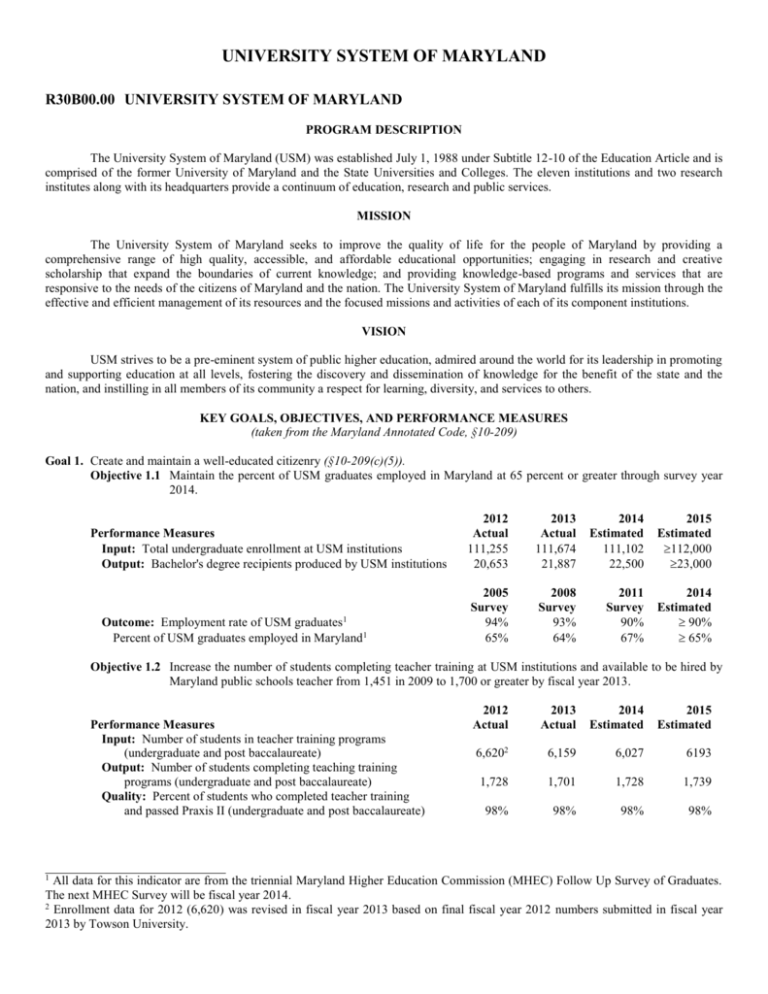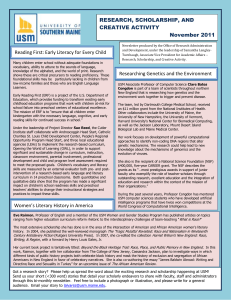R30B00USM2013.doc - University System of Maryland
advertisement

UNIVERSITY SYSTEM OF MARYLAND R30B00.00 UNIVERSITY SYSTEM OF MARYLAND PROGRAM DESCRIPTION The University System of Maryland (USM) was established July 1, 1988 under Subtitle 12-10 of the Education Article and is comprised of the former University of Maryland and the State Universities and Colleges. The eleven institutions and two research institutes along with its headquarters provide a continuum of education, research and public services. MISSION The University System of Maryland seeks to improve the quality of life for the people of Maryland by providing a comprehensive range of high quality, accessible, and affordable educational opportunities; engaging in research and creative scholarship that expand the boundaries of current knowledge; and providing knowledge-based programs and services that are responsive to the needs of the citizens of Maryland and the nation. The University System of Maryland fulfills its mission through the effective and efficient management of its resources and the focused missions and activities of each of its component institutions. VISION USM strives to be a pre-eminent system of public higher education, admired around the world for its leadership in promoting and supporting education at all levels, fostering the discovery and dissemination of knowledge for the benefit of the state and the nation, and instilling in all members of its community a respect for learning, diversity, and services to others. KEY GOALS, OBJECTIVES, AND PERFORMANCE MEASURES (taken from the Maryland Annotated Code, §10-209) Goal 1. Create and maintain a well-educated citizenry (§10-209(c)(5)). Objective 1.1 Maintain the percent of USM graduates employed in Maryland at 65 percent or greater through survey year 2014. Performance Measures Input: Total undergraduate enrollment at USM institutions Output: Bachelor's degree recipients produced by USM institutions Outcome: Employment rate of USM graduates1 Percent of USM graduates employed in Maryland1 2012 Actual 111,255 20,653 2013 Actual 111,674 21,887 2014 Estimated 111,102 22,500 2015 Estimated 112,000 23,000 2005 Survey 94% 65% 2008 Survey 93% 64% 2011 Survey 90% 67% 2014 Estimated 90% 65% Objective 1.2 Increase the number of students completing teacher training at USM institutions and available to be hired by Maryland public schools teacher from 1,451 in 2009 to 1,700 or greater by fiscal year 2013. Performance Measures Input: Number of students in teacher training programs (undergraduate and post baccalaureate) Output: Number of students completing teaching training programs (undergraduate and post baccalaureate) Quality: Percent of students who completed teacher training and passed Praxis II (undergraduate and post baccalaureate) 1 2012 Actual 2013 Actual 2014 Estimated 2015 Estimated 6,6202 6,159 6,027 6193 1,728 1,701 1,728 1,739 98% 98% 98% 98% All data for this indicator are from the triennial Maryland Higher Education Commission (MHEC) Follow Up Survey of Graduates. The next MHEC Survey will be fiscal year 2014. 2 Enrollment data for 2012 (6,620) was revised in fiscal year 2013 based on final fiscal year 2012 numbers submitted in fiscal year 2013 by Towson University. UNIVERSITY SYSTEM OF MARYLAND R30B00.00 UNIVERSITY SYSTEM OF MARYLAND (Continued) Objective 1.3 Address the State’s need for more graduates in STEM fields (science, technology, engineering, and mathematics—areas that are key to success in the knowledge economy) by increasing the number of graduates produced in these fields. 2012 2013 2014 2015 Performance Measures Actual Actual Estimated Estimated Input: Number of students enrolled in STEM programs1 34,989 37,136 ≥38,000 ≥39,000 Output: Number of graduates of STEM programs1 6,086 6,662 7,400 ≥7,800 Objective 1.4 Increase the total number of nursing graduates, baccalaureate through doctorate, produced annually by USM nursing programs from 898 in fiscal year 2009 to 1,000 or greater by fiscal year 2013. 2012 Performance Measures Actual Input: Number of undergraduate students enrolled in nursing programs 2,837 Number of graduate students enrolled in nursing programs 1,383 Output: Number of graduates of nursing programs at baccalaureate level 686 Number of graduates of nursing programs at master’s or doctorate level 387 Total number of nursing program graduates (bachelor’s through doctorate) 1,073 Quality: Percent of nursing program graduates passing the licensure examination 88%2 2013 Actual 2,813 1,390 738 415 2014 Estimated 2,975 1,276 722 441 2015 Estimated 3,085 1,204 726 423 1,153 1,163 1,149 TBA2 89% 89% 2012 Actual 111,255 2013 Actual 111,674 2014 Estimated 111,102 2015 Estimated 112,000 20,653 36.9% 21,887 36.9% 22,500 37.0% 23,000 37.0 % Goal 2. Promote economic development (§10-209(c)(5)) Objective 2.1 Increase the proportion of State residents who have a bachelor's degree. Performance Measures Input: Total undergraduate enrollment at USM institutions Output: Total number bachelor's degree recipients produced by USM institutions Outcome: Percent of State residents who have a bachelor's degree3 Objective 2.2 Maintain the ratio of median annual salary of USM graduates to the median annual salary of civilian work force with a bachelor's degree at .86 or greater through 2008. Performance Measure Output: Median salary of USM graduates4 Outcome: Ratio of median salary of USM graduates to median salary of U.S. civilian work force with a bachelor's degree 4 1 2005 Survey $38,120 2008 Survey $38,120 2011 Survey $37,778 2014 Estimated $41,000 0.91 0.93 0.79 0.85 STEM includes bachelor, master, or doctoral programs in biological sciences, computer and information sciences, engineering, mathematics, physical sciences, and natural sciences programs. 2 Fiscal year 2012 was updated in fiscal year 2013 to reflect the final, updated numbers for the July 1, 2011-June 30, 2012 time period. See http://167.102.241.38/main.php?v=ada&p=0&c=education/nlcex_stats.html. Data for fiscal year 2013 have not yet been released. 3 Percent of Maryland residents age 25 and over who have completed at least a bachelor’s degree is derived from the U.S. Bureau of the Census American Community Survey (ACC), as reported by the Maryland State Data Center. Data included are the most recent available for the reported fiscal year: 2013 equals 2012. See http://planning.maryland.gov/msdc/American_Community_Survey/2012ACS.shtml. 4 USM alumni salary data are self-reported and taken from the triennial MHEC Follow Up Survey of Graduates. The next MHEC Survey will be fiscal year 2014. National median salary data are taken from U.S. Bureau of Labor Statistics’ Annual Demographic Survey and represent the median annual earnings of all people in the U.S. age 25 years and older who have a bachelor’s degree. The national data are compared to the calculated median salary of USM undergraduate alumni one year after graduation to get the actual ratio. UNIVERSITY SYSTEM OF MARYLAND R30B00.00 UNIVERSITY SYSTEM OF MARYLAND (Continued) Objective 2.3 Through 2013 maintain the number of new start up companies formed annually as a result of technology developed by USM research institutions at 8 or greater.1 2012 Performance Measures Actual Outcome: New startup companies formed by USM institutions (annual) 6 2013 Actual 14 2014 Estimated ≥8 2015 Estimated ≥8 Goal 3. Increase access for economically disadvantaged and minority students. (§10-209(c)(6)) Objective 3.1 Through 2013 the percentage of economically disadvantaged students attending USM institutions will be at least 40 percent. 2012 2013 2014 2015 Performance Measures Actual Actual Estimated Estimated Input: Percentage of economically disadvantaged students attending USM institutions (undergraduate only) 2 46% 49% ≥ 49% ≥49 % Objective 3.2 Maintain the percentage of minority undergraduate students at 40 percent or greater through 2013. Performance Measures Output: Percentage of minority undergraduate students enrolled in USM institutions 2012 Actual 2013 Actual 2014 Estimated 2015 Estimated 43% 43% ≥ 43% ≥ 43% Objective 3.3 Maintain the percentage of African-American undergraduate students at 27 percent or greater through fiscal year 2013. 2012 2013 2014 2015 Performance Measures Actual Actual Estimated Estimated Output: Percentage of African-American undergraduate students enrolled in USM institutions 27% 26% ≥ 27% ≥27 % Objective 3.4 Increase the second-year retention rate of minority students, system-wide, to 83 percent, and increase or maintain the second-year retention rate of African-American students, system-wide, to at least 78 percent, by fiscal year 2013. Performance Measures Output: Second-year retention rate of minority students 3 Second-year retention rate of African-American students3 2012 Actual 83% 80% 2013 Actual 84% 80% 2014 Estimated ≥84% ≥ 80% 2015 Estimated ≥84% ≥80 % Objective 3.5 Increase or maintain the six-year graduation rate of minority students, system-wide, to at least 55 percent, and Increase the six-year graduation rate of African-American students, system-wide, to at least 47 percent by fiscal year 2013. 2012 2013 2014 2014 Performance Measures Actual Actual Estimated Estimated Output: Six-year graduation rate of minority students3 52% 55% ≥56% ≥56% Six-year graduation rate of African-American students3 45% 47% ≥48% ≥48% 1 Per data reported to the USM Association of University Technology Managers (AUTM). Actuals reflect most recent AUTM data. Thus, 2011 actual reflects data contained in the 2009 AUTM report; 2010 data reflect data contained in the 2008 AUTM report, etc. 2 Bowie State does not report this measure so the percentages have been adjusted to take BSU out of the denominator when calculating for USM. 3 All second-year retention and six-year graduation rates represent first-time, full-time students only, per the U.S. Department of Education’s Integrated Postsecondary Education Data System (IPEDS) reporting requirements. UNIVERSITY SYSTEM OF MARYLAND R30B00.00 UNIVERSITY SYSTEM OF MARYLAND (Continued) Goal 4. Achieve and sustain national eminence in providing quality education, research and public service (§10-209(b)) Objective 4.1 Increase the retention rate of USM undergraduates, system-wide, to at least 86 percent by fiscal year 2013. Performance Measures Output: Second-year retention rate for USM undergraduates1 2012 Actual 85% 2013 Actual 86% 2014 Estimated 86% 2015 Estimated 87% Objective 4.2 Increase the graduation rate of USM undergraduates, system-wide, to at least 68 pecent by fiscal year 2013. Performance Measures Output: Six-year graduation rate for USM undergraduates1 2012 Actual 65% 2013 Actual 66% 2014 Estimated 66% 2015 Estimated 67% Objective 4.3 Maintain prestigious awards and national academy memberships held by USM faculty at 80 or more by 2013. Performance Measures Outcome: Number of prestigious awards or national academy memberships held by USM faculty1 2012 Actual 2013 Actual 2014 Estimated 2015 Estimated 76 75 ≥ 80 ≥ 80 Objective 4.4 Increase the level of student satisfaction with education received for employment to 90 percent or greater by the 2014 survey year. 2005 2008 2011 2014 Performance Measure Survey Survey Survey Estimated Quality: Percentage of students satisfied with education received for employment (undergraduate level only) 2 87% 89% 88% ≥ 90% Objective 4.5 Maintain the level of student satisfaction with education received for graduate/professional school at 98 percent or greater through the 2014 survey year. 2005 2008 2011 2014 Performance Measure Survey Survey Survey Estimated Quality: Percentage of students satisfied with education received for graduate/professional school (undergraduate level only)2 98% 99% 98% ≥ 98 1 This indicator was changed in 2005 to include national awards, per the original concept of the indicator. Awards included in the indicator are Fulbright Scholarships, National Endowment for the Humanities Fellowships, Guggenheim Fellowships, NSF CAREER/Presidential Young Investigator Awards, and Sloan Foundation Fellowships. National academy memberships included in the total are the following: the Institute of Medicine, the American Academy of Arts and Sciences, the National Academy of Education, the National Academy of Engineering, and the National Academy of Science. 2 All data for this indicator are from the triennial Maryland Higher Education Commission (MHEC) Follow Up Survey of Graduates. The next survey is tentatively scheduled by MHEC for fiscal year 2014.







